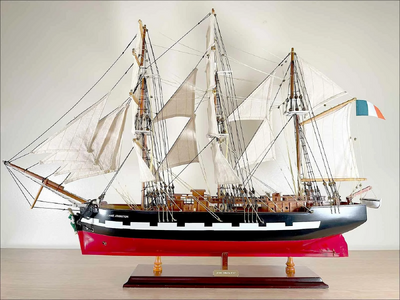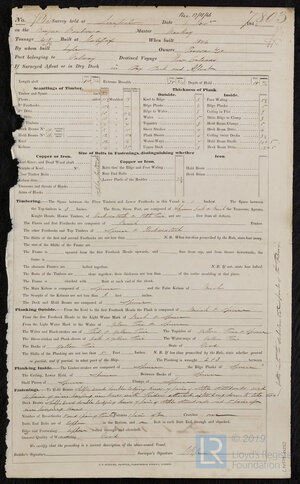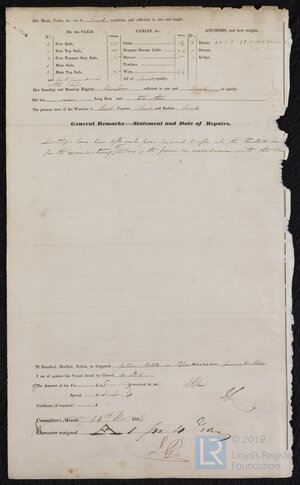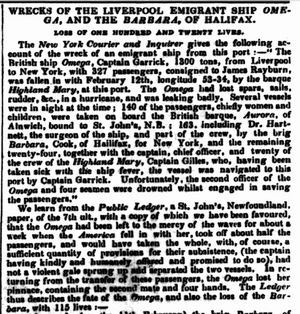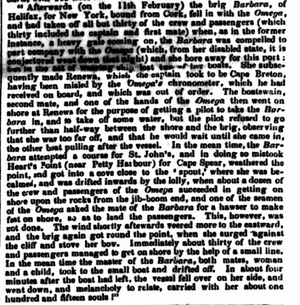You are using an out of date browser. It may not display this or other websites correctly.
You should upgrade or use an alternative browser.
You should upgrade or use an alternative browser.
Do you know the name(s) of this ship?
Yes, she is the Barbara and she transported my g-g-grandfather and mother to the States during the great Irish Famine.
Lloyd's Register has this to say about her in 1848.

She sailed from Galway on April 10, 1848, and arrived in New York on May 11, 1848.
I would like to built a typical bark from that era, but have not been able to find any kits as yet. I was thinking about trying to modify a kit or try something scratch-built if I could find plans.
Lloyd's Register has this to say about her in 1848.

She sailed from Galway on April 10, 1848, and arrived in New York on May 11, 1848.
I would like to built a typical bark from that era, but have not been able to find any kits as yet. I was thinking about trying to modify a kit or try something scratch-built if I could find plans.
- Joined
- Dec 1, 2016
- Messages
- 5,135
- Points
- 728

Jeanie Johnston was one of the coffin ship during the great Irish Famine about the same size as the Barbara
Jeanie Johnston is a replica of a three masted barque that was originally built in Quebec, Canada, in 1847 by the Scottish-born shipbuilder John Munn was a famious ship builder and some of his ship plans did survive in the Canadian archives. You can track down the Jeanir drawings.
The ship made a voyage from County Kerry to Quebec on 24 April 1848, with 193 emigrants on board, as the effects of the Famine ravaged Ireland. Between 1848 and 1855, the Jeanie Johnston made 16 voyages to North America,
Type Three-masted barque
Tonnage 301 GT
Displacement 518 t (510 long tons)
Length
47 m (154 ft 2 in) o/a
37.5 m (123 ft 0 in) on deck
Beam 8 m (26 ft 3 in)
Height 28 m (91 ft 10 in) air draft
Draft 4.6 m (15 ft 1 in)
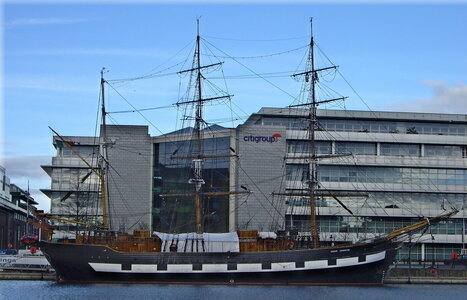
Jeanie Johnston is a replica of a three masted barque that was originally built in Quebec, Canada, in 1847 by the Scottish-born shipbuilder John Munn was a famious ship builder and some of his ship plans did survive in the Canadian archives. You can track down the Jeanir drawings.
The ship made a voyage from County Kerry to Quebec on 24 April 1848, with 193 emigrants on board, as the effects of the Famine ravaged Ireland. Between 1848 and 1855, the Jeanie Johnston made 16 voyages to North America,
Type Three-masted barque
Tonnage 301 GT
Displacement 518 t (510 long tons)
Length
47 m (154 ft 2 in) o/a
37.5 m (123 ft 0 in) on deck
Beam 8 m (26 ft 3 in)
Height 28 m (91 ft 10 in) air draft
Draft 4.6 m (15 ft 1 in)

- Joined
- Dec 1, 2016
- Messages
- 5,135
- Points
- 728

a reconstructed Coffin Ship known as the Dunbrody Famine Ship docked at New Ross, County Wexford, Ireland
you can Email the mueums Dunbrody and Jeannie Johnston and ask where the original plans are or if they sell plans of their ships. The Dunbrody and 7 sister ship were built in Canada so there may be plans in Canadian archives.
This an example where there are voids in maritime history of sips because kit makers do not make kits of such subjects. I do not think it is profitable to produce kits of Irash coffin ships. So you have to build from scratch.
The Dunbrody Famine Ship was one of eight cargo vessels that the Graves Family commissioned from the expert shipwright Thomas Hamilton Oliver.
She was built in Quebec and launched in 1845, the year that a major Potato Blight struck Ireland. In the ensuing famine more than a million people would flee the country.
i would start in Canada either the museum in Halifax or canadian archices and see what you can find out about Thomas Hamilton Oliver
you can Email the mueums Dunbrody and Jeannie Johnston and ask where the original plans are or if they sell plans of their ships. The Dunbrody and 7 sister ship were built in Canada so there may be plans in Canadian archives.
This an example where there are voids in maritime history of sips because kit makers do not make kits of such subjects. I do not think it is profitable to produce kits of Irash coffin ships. So you have to build from scratch.
The Dunbrody Famine Ship was one of eight cargo vessels that the Graves Family commissioned from the expert shipwright Thomas Hamilton Oliver.
She was built in Quebec and launched in 1845, the year that a major Potato Blight struck Ireland. In the ensuing famine more than a million people would flee the country.
i would start in Canada either the museum in Halifax or canadian archices and see what you can find out about Thomas Hamilton Oliver
Last edited:
- Joined
- Jun 17, 2021
- Messages
- 1,653
- Points
- 488

Dear Mr. Day,
Great and unique historic subject, well worthy of modelling, especially with your family history. Something to pass along to your heirs to give substance to the memory of the plight and courage of your great-great grandparents' foundation of the Day family in this country and to the country from whence they came.
Please keep us apprised of your progress on this project. You have captured my interest and undivided attention.
Pete
Great and unique historic subject, well worthy of modelling, especially with your family history. Something to pass along to your heirs to give substance to the memory of the plight and courage of your great-great grandparents' foundation of the Day family in this country and to the country from whence they came.

Please keep us apprised of your progress on this project. You have captured my interest and undivided attention.

Pete
The ship that began this inquiry was the Barbara out of Galway, a 459 ton bark under Captain Mackay. The voyage my ancestors were on left Galway on April 10, 1848 and arrived in New York on May 11, 1848. I found this picture of a three-masted barque called the Barbara in the University of Newcastle (Australia) Ross and Pat Craig Collection. There is no date on the photo. My question is--could this be the same Barbara that sailed in 1848? Is this the right rigging for a barque? I'm wondering about the mizzen mast. I'm suspicious that this is a later ship.
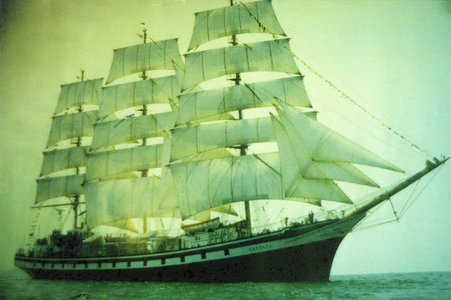

Last edited:
- Joined
- Jun 17, 2021
- Messages
- 1,653
- Points
- 488

This "Barbara" Is full rigged as the mizzen mast has square sails like the main and fore. As a bark only the fore and main would be square rigged with the mizzen fore and aft rig only. This does not mean that the ship pictured is not the same ship, as the rigs on these ships were easily altered during later re-fits for different purposes.
Last edited:
My doubts relate to the picture. Although there were photos of barks from early on, this picture looks remarkably "new." However, since it is found in an Australian collection, it is possible that the Barbara, after a few years of service out of Galway, was sold and took up transporting cargo and passengers down under. This is another line of research--can I find the names of ships arriving in Australia between 1860 and 1890.
- Joined
- Jun 17, 2021
- Messages
- 1,653
- Points
- 488

If well mastered and maintained these ships could have a long and varied service life. I hope your inquires bear fruit.
Transcription of the Report:
Lloyd’s 1846 Survey of the Barbara
# 7803
Survey held at Liverpool
Date Nov 6 1846 (Received 12/11/46)
on the Barque Barbara
Master Mackay
Tonnage 418/459
Built at Halifax in 1846 by Lyle
Owners Pearse & Co.
Port belonging to: Galway
Destined voyage New Orleans
Surveyed in dry dock and afloat
Length aloft: 110’ 0/10 Extreme breadth: 25’ 3/10 Depth of hold 18’ 4/10
Scantlings of timber
Timber and space 24“ each
1st Footbooks: 11 1/2” sided 13 moulded
2nd Foothooks: 10 ½” sided 9 ½” moulded
3rd Foothooks: 10“ sided 8” moulded
Deck timbers: 9” sided 9” moulded
Deck Beams: (No. 17) 11” sided 10” moulded
Hold beams: (no. 16) 12” sided 11½” moulded
Keel: 12” sided 10½” moulded
Kelsons: 14” sided 25” moulded
Thickness of plank
Outside Inside
Keel to bilge: 3” Foot waling: 5½”
Bilge planks: 4” Bilge planks: 5”
Bilge to wales: 3” Ceiling in flat” 3”
Topsides: 5” Ceiling bilge to clamp: 3”
Sheer strakes: 4” Hold beam clamps: 5”
Plank sheers: 4” Deck beam clamps: 4”
Water-ways: 7” Ceiling ‘twixt decks: 3½”
Upper deck: 3” Hold beam shelfs: 14” & 5”
Deck beam shelfs: 12” & 5”
Size of bolts in fastenings, distinguishing whether
Copper or Iron Copper or Iron Iron
Heel-knee and dead wood abaft: copper Bolts thro’ the bilge and foot waling: Hold beam
Searphs of keel: copper Butt end bolts: Deck beam
Floor timber bolts: copper Lower pintle of the rudder: 2¾
Kelson bolts: copper
Transoms and throats of hooks: copper
Arms of hooks: copper
Timbering: the space between the floor timbers and lower foothooks in this vessel is 1 inch. The space between the top timbers is 3 inches. The stem, stern post, are comprised of aftrican ??? & birch. The transom, aprons, knight heads, hawse timbers of ? oak & ? pine and are free from defects.
The floors and first foothooks: birch
(A number of designations are left blank)
The main kelson is comprised of spruce and the false kelson of birch
The searphs of the kelson are not less than 6 feet
The deck and hold beams are comprised of spruce
Planking outside
From the keel to the 1st foothook heads: birch and spruce
From the light water mark in the wales of yellow pine & spruce
The wales and black-strakes: red & yellow pine. The topside of: yellow pine & spruce.
The sheer-strakes and plank-sheers: oak & yellow pine. The water-ways of yellow pine
The decks of yellow pine (state of good)
The shifts of the planking are not less than 5 feet. The planking is wrought 2 & 3 between
Planking inside
The limber-strakes are comprised of spruce. Between decks spruce.
Shelf pieces spruce. Clamps spruce.
Fastenings
(Cannot read)
Her masts, yards, etc. are in good condition.
Sails: Cables s
s
2 Foresails 240 fathoms Chain 1 3/4 “ Bower 23 – 1 – 3 22 – 0 - 14
1 Fore top sail 80 fathoms Hempen stream cable 7 ½”
2 Fore topmast stay sail 75 fathoms Hawser 5”
1 Main sail Warp 4 ½”
2 Mail top sails 7 fathoms
And full ??? in other sails
She has 1 long boat and 2 others
The state of her windlass, capstan and rudder are good.
Surveyor: William Pope
Classification: A1 for 4 years
Lloyd’s 1846 Survey of the Barbara
# 7803
Survey held at Liverpool
Date Nov 6 1846 (Received 12/11/46)
on the Barque Barbara
Master Mackay
Tonnage 418/459
Built at Halifax in 1846 by Lyle
Owners Pearse & Co.
Port belonging to: Galway
Destined voyage New Orleans
Surveyed in dry dock and afloat
Length aloft: 110’ 0/10 Extreme breadth: 25’ 3/10 Depth of hold 18’ 4/10
Scantlings of timber
Timber and space 24“ each
1st Footbooks: 11 1/2” sided 13 moulded
2nd Foothooks: 10 ½” sided 9 ½” moulded
3rd Foothooks: 10“ sided 8” moulded
Deck timbers: 9” sided 9” moulded
Deck Beams: (No. 17) 11” sided 10” moulded
Hold beams: (no. 16) 12” sided 11½” moulded
Keel: 12” sided 10½” moulded
Kelsons: 14” sided 25” moulded
Thickness of plank
Outside Inside
Keel to bilge: 3” Foot waling: 5½”
Bilge planks: 4” Bilge planks: 5”
Bilge to wales: 3” Ceiling in flat” 3”
Topsides: 5” Ceiling bilge to clamp: 3”
Sheer strakes: 4” Hold beam clamps: 5”
Plank sheers: 4” Deck beam clamps: 4”
Water-ways: 7” Ceiling ‘twixt decks: 3½”
Upper deck: 3” Hold beam shelfs: 14” & 5”
Deck beam shelfs: 12” & 5”
Size of bolts in fastenings, distinguishing whether
Copper or Iron Copper or Iron Iron
Heel-knee and dead wood abaft: copper Bolts thro’ the bilge and foot waling: Hold beam
Searphs of keel: copper Butt end bolts: Deck beam
Floor timber bolts: copper Lower pintle of the rudder: 2¾
Kelson bolts: copper
Transoms and throats of hooks: copper
Arms of hooks: copper
Timbering: the space between the floor timbers and lower foothooks in this vessel is 1 inch. The space between the top timbers is 3 inches. The stem, stern post, are comprised of aftrican ??? & birch. The transom, aprons, knight heads, hawse timbers of ? oak & ? pine and are free from defects.
The floors and first foothooks: birch
(A number of designations are left blank)
The main kelson is comprised of spruce and the false kelson of birch
The searphs of the kelson are not less than 6 feet
The deck and hold beams are comprised of spruce
Planking outside
From the keel to the 1st foothook heads: birch and spruce
From the light water mark in the wales of yellow pine & spruce
The wales and black-strakes: red & yellow pine. The topside of: yellow pine & spruce.
The sheer-strakes and plank-sheers: oak & yellow pine. The water-ways of yellow pine
The decks of yellow pine (state of good)
The shifts of the planking are not less than 5 feet. The planking is wrought 2 & 3 between
Planking inside
The limber-strakes are comprised of spruce. Between decks spruce.
Shelf pieces spruce. Clamps spruce.
Fastenings
(Cannot read)
Her masts, yards, etc. are in good condition.
Sails: Cables
 s
s2 Foresails 240 fathoms Chain 1 3/4 “ Bower 23 – 1 – 3 22 – 0 - 14
1 Fore top sail 80 fathoms Hempen stream cable 7 ½”
2 Fore topmast stay sail 75 fathoms Hawser 5”
1 Main sail Warp 4 ½”
2 Mail top sails 7 fathoms
And full ??? in other sails
She has 1 long boat and 2 others
The state of her windlass, capstan and rudder are good.
Surveyor: William Pope
Classification: A1 for 4 years
Your doubts are well founded. That ship was built much later than 1845. She appears to be an iron-hulled vessel; most of those were built between 1870 and 1900. She also is significantly larger and has upper and lower topsails. An average packet in the mid-19th century would have had single topsails. The survey you found is wonderful.My doubts relate to the picture.
Check out Howard Chapelle's book The History of American Sailing Ships. Chapelle presents information about the Queen of the West, a trans-Atlantic packet of characteristic design for the type. She was built in New York in 1843 and sailed between New York and Liverpool. While somewhat larger than the Barbara (172'-7" LWL, 37'-0" beam, 1168 tons) and a full-rigged ship, I believe that if you modified her lines to conform to the dimensions on the survey, you would be pretty close to what the Barbara looked like. I've attached pics of Chapelle's drawings.
Fair winds and keep us informed of your progress!
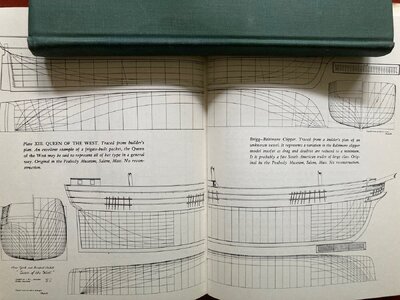
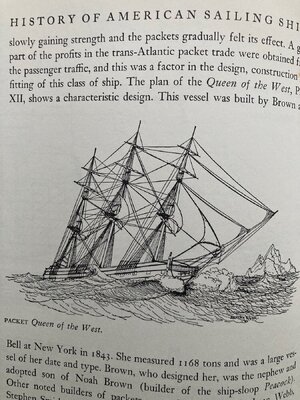
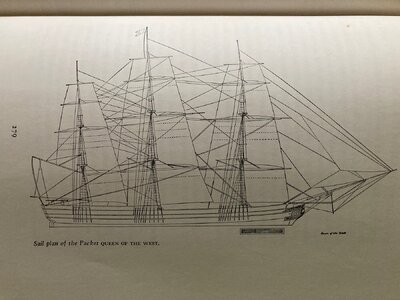
Thanks much for the reference to Chapelle's book. I have it on order to take a look at it.
I continue to research the Barbara and see that she was probably built originally as a cargo ship. There are numerous references to her making voyages between Liverpool and St. Petersburgh and Montreal and Liverpool, as well as at least four voyages to the States carrying emigrants (three to New York and one to New Orleans). Mysteriously, however, after 1851, she simply disappears from Lloyd's Register as well as any references to her in British newspapers. She may have been sold, scuttled or wrecked--although I doubt the latter because there probably would have been a mention of such an accident in the newspapers. Her Captain shows up in command of another vessel about this time.
Meanwhile, I ran across a site selling a model of completed Swedish bark (1862). The great part about this site is that there are links to plans and detailed drawings of the ship as it was constructed built from scratch. (https://www.modelships.de/Kierkegaard-barque/Kierkegaard-barque.htm) There are 5 sheets of plans plus almost 75 drawings. So, the question is: would this be a good place to start planning a build of the Barbara, assuming I cannot find the plans for the Barbara herself?
I continue to research the Barbara and see that she was probably built originally as a cargo ship. There are numerous references to her making voyages between Liverpool and St. Petersburgh and Montreal and Liverpool, as well as at least four voyages to the States carrying emigrants (three to New York and one to New Orleans). Mysteriously, however, after 1851, she simply disappears from Lloyd's Register as well as any references to her in British newspapers. She may have been sold, scuttled or wrecked--although I doubt the latter because there probably would have been a mention of such an accident in the newspapers. Her Captain shows up in command of another vessel about this time.
Meanwhile, I ran across a site selling a model of completed Swedish bark (1862). The great part about this site is that there are links to plans and detailed drawings of the ship as it was constructed built from scratch. (https://www.modelships.de/Kierkegaard-barque/Kierkegaard-barque.htm) There are 5 sheets of plans plus almost 75 drawings. So, the question is: would this be a good place to start planning a build of the Barbara, assuming I cannot find the plans for the Barbara herself?
Is this the same Barbara?
In 1848
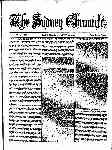
 trove.nla.gov.au
trove.nla.gov.au
In 1848
WRECKS OF THE LIVERPOOL EMIGRANT SHIP OMEGA, AND THE BARBARA, OF HALIFAX. - LOSS OF ONE HUNDRED AND TWENTY LIVES. - Sydney Chronicle (NSW : 1846 - 1848) - 12 Aug 1848
The New York Courier and Inquirer gives the following account of the wreck of an emigrant ship from this port:—"The British ship Omega, Captain Garrick, 1300 tons, from Liverpool to New York, with 327 passengers, consigned to James Rayburn, ...
Yes, I ran across that reference. However, that wreck occurred in August of 1848. The Captain of that Barbara was Cooke and she is identified as a brig. The Barbara I am researching was under the command of James MacKay from 1846 through 1849. The manifests in New York and New Orleans all mention MacKay as Master and that the Barbara is a bark. Nonetheless, that must have been a harrowing accident.
The problem with researching the Barbara is that there were many ships by the same name.
In Lloyd's Register if Shipping for 1848, there are listed five Barbara's--three of them Barks! Captain Hegerty was involved in transporting emigrants from Ireland to New Orleans and Philadelphia and always identified his vessel as "the Barque Barbara." I am not sure, but I think Baker's Barbara was used exclusively for cargo (not passengers). James MacKay was Captain of the Barbara that carried my ancestors to New York in 1848. The owner of the Barbara was Persse & Co. and it was built in Halifax in 1846. YMA5 in the listing indicates that she was sheathed in "yellow metal" and "O.S.B" indicates she was constructed of oak, beech and spruce.
It's interesting that when we use the phrase "A one" we are using a designation originated by Lloyd's to classify ships.
I haven't looked carefully, but it's interesting that the Barbara mention in the shipwreck article above under Cooke is not mentioned in Lloyd's in 1845, 1846, 1847 or 1848 (when she sank).


In Lloyd's Register if Shipping for 1848, there are listed five Barbara's--three of them Barks! Captain Hegerty was involved in transporting emigrants from Ireland to New Orleans and Philadelphia and always identified his vessel as "the Barque Barbara." I am not sure, but I think Baker's Barbara was used exclusively for cargo (not passengers). James MacKay was Captain of the Barbara that carried my ancestors to New York in 1848. The owner of the Barbara was Persse & Co. and it was built in Halifax in 1846. YMA5 in the listing indicates that she was sheathed in "yellow metal" and "O.S.B" indicates she was constructed of oak, beech and spruce.
It's interesting that when we use the phrase "A one" we are using a designation originated by Lloyd's to classify ships.
I haven't looked carefully, but it's interesting that the Barbara mention in the shipwreck article above under Cooke is not mentioned in Lloyd's in 1845, 1846, 1847 or 1848 (when she sank).




